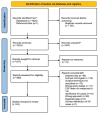Skull Base Repair following Resection of Vestibular Schwannoma: A Systematic Review (Part 2: The Translabyrinthine Approach)
- PMID: 39444760
- PMCID: PMC11495917
- DOI: 10.1055/a-2222-0016
Skull Base Repair following Resection of Vestibular Schwannoma: A Systematic Review (Part 2: The Translabyrinthine Approach)
Abstract
Objectives Despite advances in skull base reconstruction techniques, cerebrospinal fluid (CSF) leaks remain a relatively common complication after translabyrinthine (TL) vestibular schwannoma (VS) surgery. We conducted a systematic review to synthesize the repair techniques and materials used in TL VS surgery to prevent CSF leaks. Design A systematic review of studies published since 2000 reporting techniques to prevent CSF leaks during adult TL VS surgery was conducted. A narrative synthesis of primary repair protocols was produced, and a taxonomy was established. Additionally, the advantages, disadvantages, and associated CSF leak rates of different repair protocols were extracted. Results All 43 studies were case series, and 39 were retrospective. Repair strategies included heterogeneous combinations of autografts, xenografts, and synthetic materials. A taxonomy was produced, classifying repairs into seven distinct stages, including approaches to the dura, middle ear cleft, air cells, TL bony defect, extra-cranial soft tissue, postoperative dressings, and CSF diversion. The median postoperative incidence of CSF leaks was 6% (interquartile range: 0-10%). Conclusions This systematic review reveals substantial inter-institutional heterogeneity in intraoperative strategies to prevent CSF leaks following TL VS surgery. However, comparing these techniques is challenging due to the multiple predictive factors for CSF leaks and their inconsistent reporting. We propose a taxonomy of seven stages to classify operative techniques and materials aimed at preventing CSF leaks. We recommend that future evaluations should adopt a prospective approach encompassing data collection strategies that considers all operative stages described by our taxonomy.
Keywords: CSF leak; ear nose and throat; neurosurgery; skull base repair; translabyrinthine approach; vestibular schwannoma.
The Author(s). This is an open access article published by Thieme under the terms of the Creative Commons Attribution License, permitting unrestricted use, distribution, and reproduction so long as the original work is properly cited. ( https://creativecommons.org/licenses/by/4.0/ ).
Conflict of interest statement
Conflict of Interest None declared.
Figures
Similar articles
-
Skull Base Repair following Resection of Vestibular Schwannoma: A Systematic Review (Part 1: The Retrosigmoid Approach).J Neurol Surg B Skull Base. 2024 Jan 22;85(Suppl 2):e117-e130. doi: 10.1055/a-2222-0184. eCollection 2024 Oct. J Neurol Surg B Skull Base. 2024. PMID: 39444767 Free PMC article.
-
Are there modifiable risk factors to prevent a cerebrospinal fluid leak following vestibular schwannoma surgery?J Neurosurg. 2015 Feb;122(2):312-6. doi: 10.3171/2014.10.JNS14432. Epub 2014 Nov 21. J Neurosurg. 2015. PMID: 25415063
-
Evolution of the graded repair of CSF leaks and skull base defects in endonasal endoscopic tumor surgery: trends in repair failure and meningitis rates in 509 patients.J Neurosurg. 2019 Mar 1;130(3):861-875. doi: 10.3171/2017.11.JNS172141. Epub 2018 May 11. J Neurosurg. 2019. PMID: 29749920
-
Surgical repair of spontaneous cerebrospinal fluid (CSF) leaks: A systematic review.Laryngoscope Investig Otolaryngol. 2017 Apr 7;2(5):215-224. doi: 10.1002/lio2.75. eCollection 2017 Oct. Laryngoscope Investig Otolaryngol. 2017. PMID: 29094066 Free PMC article. Review.
-
Minimally invasive endoscopic repair of refractory lateral skull base cerebrospinal fluid rhinorrhea: case report and review of the literature.Neurosurg Focus. 2018 Mar;44(3):E8. doi: 10.3171/2017.12.FOCUS17664. Neurosurg Focus. 2018. PMID: 29490552 Review.
References
-
- Sughrue M E, Yang I, Aranda D et al.Beyond audiofacial morbidity after vestibular schwannoma surgery. J Neurosurg. 2011;114(02):367–374. - PubMed
-
- McRackan T R, Brackmann D E. Historical perspective on evolution in management of lateral skull base tumors. Otolaryngol Clin North Am. 2015;48(03):397–405. - PubMed
-
- Ansari S F, Terry C, Cohen-Gadol A A. Surgery for vestibular schwannomas: a systematic review of complications by approach. Neurosurg Focus. 2012;33(03):E14. - PubMed
-
- Fang C, Zhu T, Zhang P, Xia L, Sun C. Risk factors of neurosurgical site infection after craniotomy: a systematic review and meta-analysis. Am J Infect Control. 2017;45(11):e123–e134. - PubMed
LinkOut - more resources
Full Text Sources



